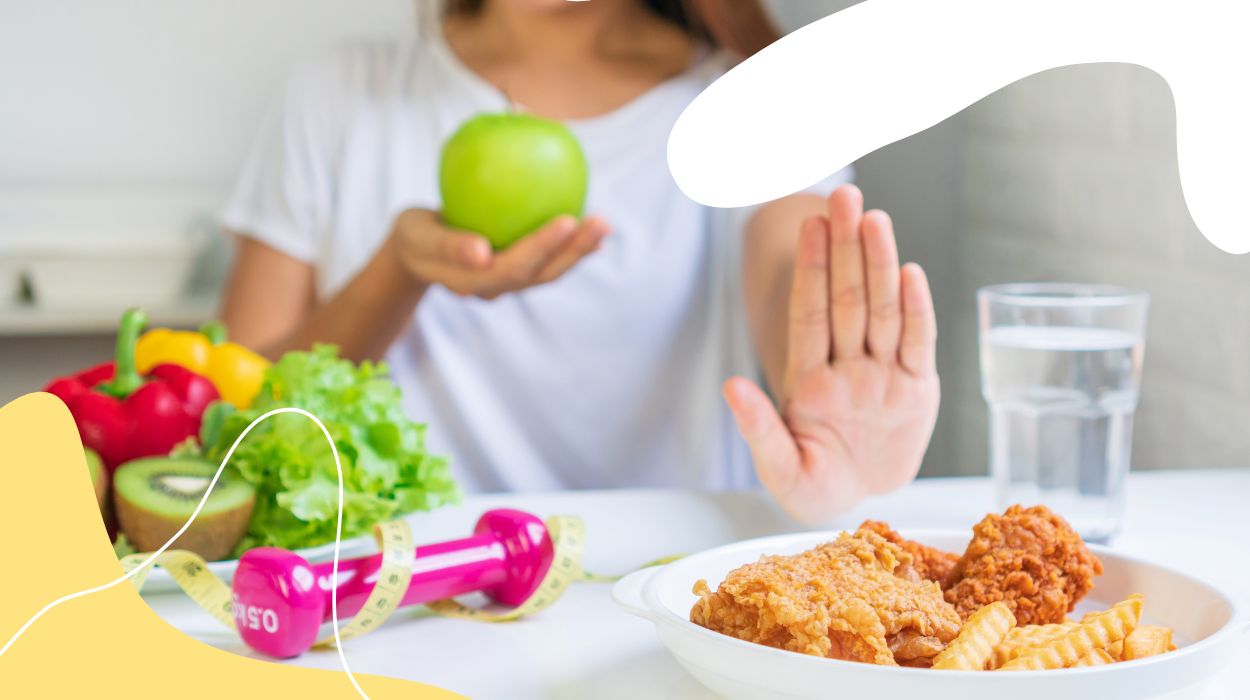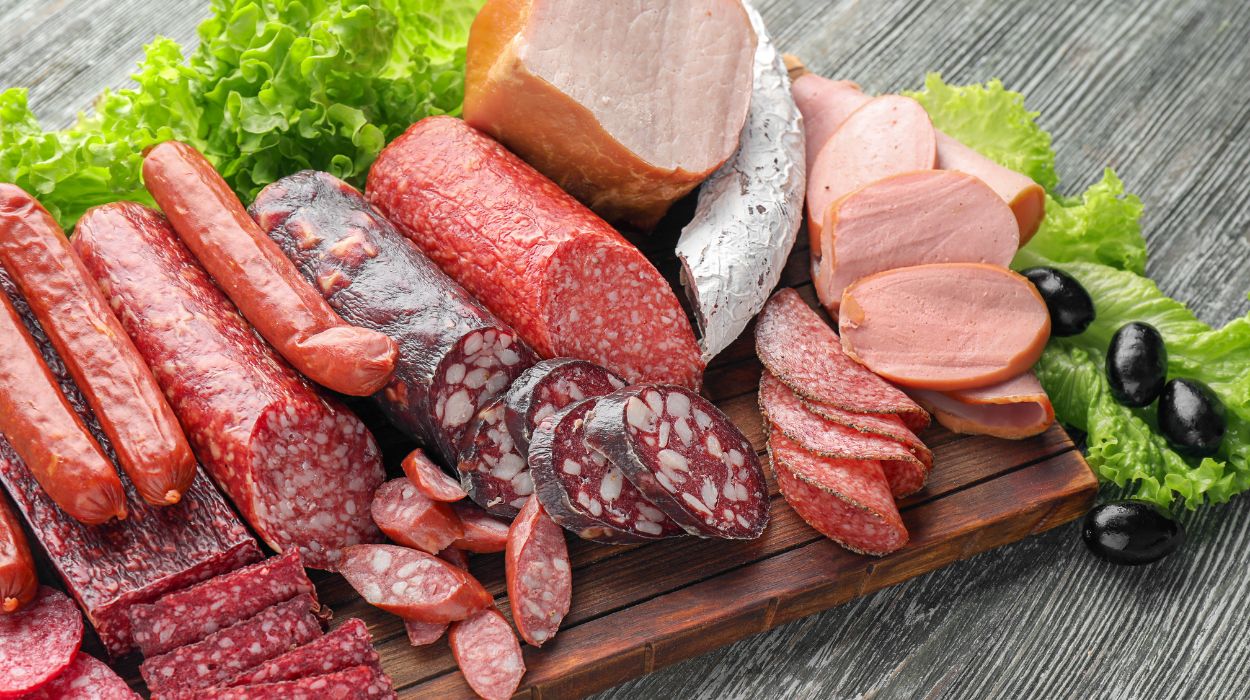 Expert's opinion
Expert's opinion
Expert's opinion
The article is a subjective view on this topic written by writers specializing in medical writing.
It may reflect on a personal journey surrounding struggles with an illness or medical condition, involve product comparisons, diet considerations, or other health-related opinions.
Although the view is entirely that of the writer, it is based on academic experiences and scientific research they have conducted; it is fact-checked by a team of degreed medical experts, and validated by sources attached to the article.
The numbers in parenthesis (1,2,3) will take you to clickable links to related scientific papers.
8 Foods To Avoid To Lose Weight In 2024

When it comes to what to avoid when losing weight, most of us know the basics. Fat? Carbs? Red meat? What’s left?
We love smoothies, salads, homemade meals and snacks, and natural supplements that help us burn fat while we diet. Some “healthy” options, though, may not be as good for us as we may think while shopping at the grocery store. What are the best belly fat foods to avoid for weight loss?
A word to the wise: it’s not all potato chips and refined grains. Some items on this list may shock you. Who would have thought that some of these options could lead to weight gain?
Our Top 8 Foods To Avoid For Weight Loss
Leaving these eight foods to avoid for weight loss in the past may help you get the ball rolling, especially if you find yourself struggling to achieve real results:
- Convenience Food and Junk Food
- Sugar-Sweetened Beverages
- Alcohol
- Partially-Hydrogenated and Hydrogenated Vegetable Oils
- Processed Meat
- Store-Bought Sauces and Dressings
- White Bread
- Anything From a Restaurant
Foods To Avoid When Losing Weight
What’s the best way to prevent weight gain while dieting? We all know the drill: choose calorically bereft, high-fiber, low-fat foods that fill you up without weighing you down.
However, what you choose to eat may not be as influential as what you choose to remove from your diet.
So, we’ve got our list of the usual suspects, but what about the facts backing each of these claims up?
There’s plenty of science that can speak to the benefit of rejecting these empty calories if you’re trying to lose weight. Here’s what we learned.
Convenience Food and Junk Food
Junk food and convenience food come in many forms, and all of them can be extraordinarily detrimental to your weight loss goals.
What foods should you be avoiding to lose weight? We’ve narrowed things down to the following:
- Fast food
- Frozen food
- Fried food, including fried potatoes like french fries
- Candy bars
- Snack foods like potato chips
- Some “Meal replacements” like protein bars and granola bars
- Soft drinks, including diet soda
- Processed foods like instant noodles
- Baked goods, even ones marketed as being “healthy” or “all-natural”
This list is far from comprehensive, but the idea is that if a choice consists of refined carbohydrates, added fats, extra sodium, and added sugar, it’s likely high calorie and full of trans fatty acids and other preservatives and additives with little nutritional value.
Sugary foods, fried foods, and processed foods open the door to a host of chronic diseases in the long term[1], such as heart disease, type II diabetes, non-alcoholic fatty liver disease, and even some forms of cancer.
If you need good fuel fast, keep healthy, convenient options on hand—grilled chicken, dark chocolate, Greek yogurt, fresh fruit, and even 100% pure fruit juices may be able to stand in for your usual french fries, potato chips, candy bars, white bread, and diet soda, all laden with saturated or trans fat, refined grains, and other chemicals and ingredients that may impede the road to fat loss that lasts.
Trans fat is on the list because it is the most dangerous type of fat[2] to eat, considering the risk for heart disease. It raises bad cholesterol and lowers good cholesterol. Trans fats are so bad for you that the Food and Drug Administration (FDA) has banned the addition of major artificial trans fats to foods and beverages, while some cities and countries have banned their use altogether. Trans fats also make you fatter than other sources of calories and increase abdominal fat[3].
Sugar-Sweetened Beverages
How much sugar is too much to eat daily? Experts recommend[4] limiting the amount of refined sugar that you consume every day to around 25 grams for women and approximately 38 grams for men.
Needless to say, that doesn’t leave a whole lot of room for the good stuff. Many Americans eat as much as 82 grams of sugar daily on average. Refined, added sugar in all forms, including high-fructose corn syrup, are all terrible foods for weight loss and will have a far-from-optimal impact on your glycemic index, leaving you more likely to crash and to over-indulge later on.
Consuming too much “high-dose” sugar has been shown to increase one’s likelihood of chronic disease later on, such as the possibility of becoming obese, developing metabolic syndrome, type II diabetes, cardiovascular disease, some forms of cancer, Alzheimer’s disease, and even falling victim to advanced cellular aging.
This doesn’t necessarily mean that you should be reaching for sweet drinks with fewer calories. Thanks to artificial sweeteners, diet sodas are often substituted for high-sugar options, but paradoxically, fake sugar has been linked to obesity in the long term, perhaps because consumers perceive a less satisfying snack or meal psychologically[5]. For this reason, we consider sugary beverages and diet sodas to be some of the worst foods for weight management.
Instead of tiding yourself over with your favorite Dr. Pepper or sugary coffee drink, we suggest trying a slightly more sustaining snack, possibly with filling fiber, whole grains, or any other nutritional value. Liquid calories will only leave you fading—this most certainly includes one of the top offenders overall: alcohol, the king of sugary drinks.
Alcohol

Drinking alcohol may very well be one of the worst decisions you can make if you want to lose weight: it’s high-calorie, offers no health benefits, and doing away with it leaves more room for additional food in your healthy diet, food that may help boost your metabolism instead of hindering it.
By some reports, out-of-control alcohol addiction may add upwards of 384.8 calories[6] to your daily intake on average, but that’s far from the worst of what booze will do for your waistline, added sugar aside. Recall that not all alcohol is sugary but is bad for you nevertheless because of unneeded calories. Whiskey and hard liquor have 0.0 grams of sugar but still contain calories that may be quickly stored as fat.
Alcohol may further frustrate your weight loss efforts by impacting the quality of the foods that you choose to include in your weight loss diet. You’re more likely to grab unnecessary empty calories. It’s much more difficult to maintain a balanced diet with so many more calories entering the scene overall.
Partially Hydrogenated and Hydrogenated Vegetable Oils
Hydrogenated oil is found in many processed foods, such as margarine, vegetable shortening, pre-made dough, fried food, coffee creamers, pastries, confections, processed snacks, and even in things like the flavored yogurt coating on raisins, nuts, or pretzels. It’s not recognized as being fit for human consumption by the scientific community at large or even by the FDA[7]. Why should it have a place in your weight loss diet?
If you’re trying to lose weight, we can highly recommend leaving all hydrogenated and partially hydrogenated oils off of your diet, no matter what form you find them in. Instead of relying only on the nutrition facts labeling your food, trawl carefully through the list of ingredients for hydrogenated oil hiding under any of these common and misleading names:
- Partially hydrogenated cottonseed oil
- Partially hydrogenated palm oil
- Partially hydrogenated soybean oil
- Partially hydrogenated vegetable oil
- Trans fats
- Trans fatty acids
- Partially hydrogenated canola oil
When cooking at home, stick to healthy fats like olive oil and avocado oil if you’re trying to lose weight. The best foods for weight loss take the place of more questionable options out of your hands, fueling your day without slowing you down. For example, homemade power muffins made with whole grains and Greek yogurt might end up being superior to your usual Egg McMuffin on the way to school or the office in the morning.
Processed Meat

Deli meat. Hot dogs. Canned meat is like Spam. How much weight can you lose when you avoid foods like processed meats? They could be one of the most important belly fat foods to avoid for weight loss if you gravitate toward deli meats and other fast options when you’re hungry.
Much like red meat, the over-consumption of processed meats has been shown to increase one’s odds of becoming diabetic. According to research, a mechanism may be attributed primarily to the weight gained compared to trial participants adhering to a strictly vegetarian diet[8]. The meat eaters’ diets included franks, cured and processed fish, and other types of preserved meat products, all high in sodium and trans fats naturally.
Processed meats are one of the top three foods to avoid if you want to lose weight and manage your blood sugar; even in non-diabetics, deli meats and other processed foods like them may negatively impact[9] one’s insulin resistance overall after eating, leading to further dietary and metabolic dysfunction later on, including colorectal cancer[10].
Store-Bought Sauces and Dressings
Commercial salad dressing and sauces are delicious for a reason—tons of added sugar, incredible amounts of fat, preservatives, artificial stabilizers, and emulsifiers all transform delicious, whole foods into something decidedly less-than-healthy when all is said and done.
Many creamy dressings are loaded with mayonnaise, sour cream, oil, and tons of other additives and ingredients that are far from low-fat. If you love salads and other types of grain bowls with some sort of tangy or savory sauce, one way to avoid weight gain is to simply mix your homemade salad dressing or sauce up at home with simple, wholesome ingredients.
At this juncture, you may be tempted to opt for an oil-free alternative, but a low-fat homemade dressing may not always be the way to go, even when trying to avoid weight gain. Some lipids are highly beneficial to the body’s ability to absorb the nutrients in vegetables[11] and may even play a positive role in overall satisfaction after eating a meal.
Our favorite salad dressings for weight loss sub in things like Greek yogurt, tahini, avocado, vinegar, and healthy oils and fats for a lighter alternative.
Processed Bread
White bread and other processed bread products made with white flour will certainly spike your blood sugar, much more so than options still in their whole-grain form[12], such as whole-grain bread.
While ordinary bread may often be lower in calories[13] than whole-grain bread, this benefit often comes at the cost of the nutritional value of the slice—wheat bread made from whole grains often contains more protein, more fiber, and more micronutrients than white bread, produced from commercially-bleached and -refined flour that’s been stripped of the wheat hull and wheat germ.
At any rate, you can’t go wrong by baking your bread at home with whole wheat flour if you have the time and interest. If not, whole-grain Basmati rice offers a lower glycemic option for a quick carbohydrate pick-me.
Anything From a Restaurant
Finally, what might be the absolute worst thing to eat for weight loss, no matter who you are or where you live: food from restaurants is often, nay, nearly always astronomically bad for you. There’s a reason your favorite place to eat keeps you and your crew always coming back for more.
Food from restaurants may be misleadingly unhealthy; “grilled” meats may often be cooked with inordinate amounts of oil and sodium, and even salads will often be full of cheese, bacon bits, and, of course, dressings and sauces that are usually always very rich in fat and calories.
This is to say nothing of the dessert menu; a single slice of the Oreo Dream Extreme Cheesecake from The Cheesecake Factory, for example, brings upwards of 1,600 calories and 133 grams of sugar to the table, and that’s not even taking the meal before it into consideration.
Most restaurants have guides in-store or online that list the caloric content of everything on the menu—if you would like to prevent weight gain, you should always take a peek at what you’re putting on your plate, and the truth may shock you. Eating a full take-out or sit-down restaurant meal even once a week may increase your BMI by up to 0.8[14] on average.
To avoid weight gain, we believe so deeply in the power of simply cooking at home[15] when dieting. If you know what every ingredient going into the meal offers, you’ll never be in the dark about what you’re eating. You’ll also be eating exactly what you like, how you like it. Have it your way, and prevent weight gain right from the get-go.
The Worst Food for Weight Loss: Our Best Advice
It’s so easy to use the food on your plate to boost your metabolism, increase your daily energy levels, and prevent unnecessary weight gain from setting in.
Avoiding these unhealthy foods will not only improve your appearance and body composition—you’ll feel better, and you’ll be more focused and present for everything important in your life. The right choices might not always be obvious, but you’ll know immediately when you’ve found a true winner.
+ 16 sources
Health Canal avoids using tertiary references. We have strict sourcing guidelines and rely on peer-reviewed studies, academic researches from medical associations and institutions. To ensure the accuracy of articles in Health Canal, you can read more about the editorial process here
- Wa.gov.au. (2022). Junk food. [online] Available at: https://www.healthywa.wa.gov.au/Articles/J_M/Junk-food#:~:text=Eating%20junk%20food%20on%20a,liver%20disease%20and%20some%20cancers.
- Medlineplus.gov. (2020). Facts about trans fats: MedlinePlus Medical Encyclopedia. [online] Available at: https://medlineplus.gov/ency/patientinstructions/000786.htm.
- Semenkovich, C.F., Goldberg, A.C. and Goldberg, I.J. (2016). Disorders of Lipid Metabolism. [online] pp.1660–1700. doi:https://doi.org/10.1016/b978-0-323-29738-7.00037-x.
- White, J.R. (2018). Sugar. Clinical Diabetes, [online] 36(1), pp.74–76. Available at: https://www.ncbi.nlm.nih.gov/labs/pmc/articles/PMC5775006/
- Pearlman, M., Obert, J. and Casey, L. (2017). The Association Between Artificial Sweeteners and Obesity. Current Gastroenterology Reports, [online] 19(12). Available at: https://pubmed.ncbi.nlm.nih.gov/29159583/
- An, R. (2016). Beverage Consumption in Relation to Discretionary Food Intake and Diet Quality among US Adults, 2003 to 2012. Journal of the Academy of Nutrition and Dietetics, [online] 116(1), pp.28–37. Available at: https://www.jandonline.org/article/S2212-2672(15)01258-7/fulltext
- Voelker, R. (2015). Partially Hydrogenated Oils Are Out. JAMA, 314(5), p.443.
- Vang, A., Singh, P.N., Lee, J.W., Haddad, E.H. and Brinegar, C.H. (2008). Meats, Processed Meats, Obesity, Weight Gain and Occurrence of Diabetes among Adults: Findings from Adventist Health Studies. Annals of Nutrition and Metabolism, [online] 52(2), pp.96–104. Available at: https://pubmed.ncbi.nlm.nih.gov/18349528/
- Tucker, L.A., LeCheminant, J.D. and Bailey, B.W. (2015). Meat Intake and Insulin Resistance in Women without Type 2 Diabetes. Journal of Diabetes Research, [online] 2015, pp.1–10. Available at: https://www.ncbi.nlm.nih.gov/labs/pmc/articles/PMC4512604/
- Santarelli, R., Pierre, F. and Corpet, D. (2008). Processed Meat and Colorectal Cancer: A Review of Epidemiologic and Experimental Evidence. Nutrition and Cancer, [online] 60(2), pp.131–144. Available at: https://pubmed.ncbi.nlm.nih.gov/18444144/
- White, W.S., Zhou, Y., Crane, A., Dixon, P., Quadt, F. and Flendrig, L.M. (2017). Modeling the dose effects of soybean oil in salad dressing on carotenoid and fat-soluble vitamin bioavailability in salad vegetables. The American Journal of Clinical Nutrition, [online] 106(4), pp.1041–1051. Available at: https://www.ncbi.nlm.nih.gov/labs/pmc/articles/PMC5611781/
- Burton, P.M., Monro, J.A., Alvarez, L. and Gallagher, E. (2011). Glycemic Impact and Health: New Horizons in White Bread Formulations. Critical Reviews in Food Science and Nutrition, [online] 51(10), pp.965–982. Available at: https://pubmed.ncbi.nlm.nih.gov/21955095/
- Ulatowski, L. and Marusic, M. (2021). Is Wheat Bread a Better Choice Than White Bread? Current Developments in Nutrition, [online] 5(Supplement_2), pp.568–568. Available at: https://www.ncbi.nlm.nih.gov/labs/pmc/articles/PMC8181512/
- Bhutani, S., Schoeller, D.A., Walsh, M.C. and McWilliams, C. (2016). Frequency of Eating Out at Both Fast-Food and Sit-Down Restaurants Was Associated With High Body Mass Index in Non-Large Metropolitan Communities in Midwest. American Journal of Health Promotion, [online] 32(1), pp.75–83. Available at: https://www.ncbi.nlm.nih.gov/labs/pmc/articles/PMC5453830/
- Mills, S., Brown, H., Wrieden, W., White, M. and Adams, J. (2017). Frequency of eating home cooked meals and potential benefits for diet and health: cross-sectional analysis of a population-based cohort study. International Journal of Behavioral Nutrition and Physical Activity, [online] 14(1). Available at: https://www.ncbi.nlm.nih.gov/labs/pmc/articles/PMC5561571/



